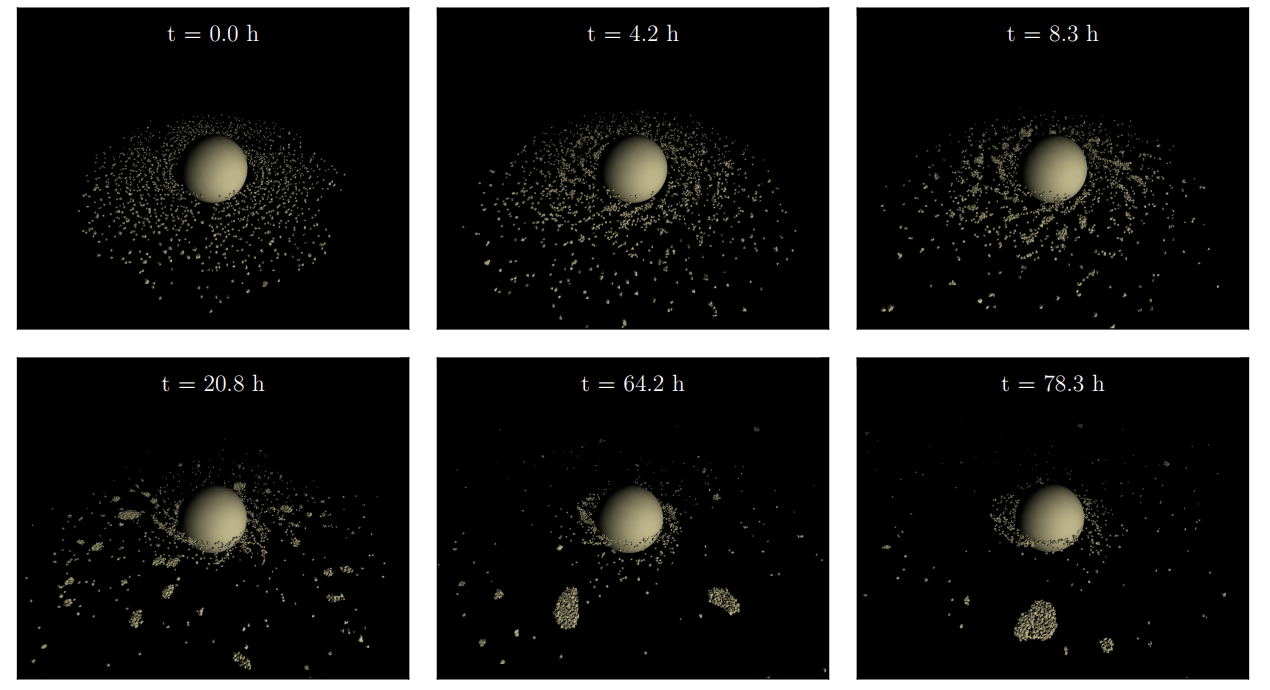Rapid formation of binary asteroid systems post rotational failure: a recipe for making atypically shaped satellites
- 1University of Bern, Physics Institute, Space Research & Planetary Sciences (WP), Bern, Switzerland
- 2Department of Aerospace Science and Technology, Politecnico di Milano, Milan, Italy
- 3Université Paris Cité, Institut de Physique du Globe de Paris, CNRS, Paris, France
- 4Colorado Center for Astrodynamics Research, University of Colorado Boulder, Boulder, USA
Recent observations of asteroid satellites with unexpected shapes, such as the spherically oblate Dimorphos observed by NASA’s DART mission [1] or the bilobate contact binary satellite Selam imaged by the Lucy spacecraft [2], have highlighted the complexity of binary asteroid formation. Previous theories focused on long-term spin-up of rubble pile asteroids leading to slow, continuous mass-shedding [3] or rotational fission [4] can account for the predominantly prolate population given their shape due to tidal forces, keeping the satellite's shape intact and often putting it in a synchronous orbit but struggle to explain the existence of Dimorphos and Selam [5,6]. Scenarios where the spinning asteroid has increased structural integrity due to e.g. a small amount of cohesion [7] lead to debris disks that extend to the fluid Roche limit of the primary, generated from a rotational failure that results in an instantaneous, chaotic mass-shedding [5,6]. In our work, we have investigated and identified the dynamical mechanisms that determine the shape of satellites in such disks using a combination of three-dimensional smoothed-particle hydrodynamics (SPH) and non-spherical N-body codes [6].
In our method, we performed two series of spin-up simulations of a Ryugu-like and a Didymos-like primary body with the Bern SPH code [8]. Then, we used the initial conditions generated from the resulting debris disks post rotational failure to study satellite formation with the N-body code GRAINS [9]. To transition between the two different codes, we perform a hand-off. This is necessary due to SPH needing a large number of particles (around 106) to improve realism which would significantly slow down an N-body simulation. Moreover, SPH particles are constituents of a smoothed continuum and will as a result often overlap physically which causes numerical issues for N-body codes. The interface detects clusters of SPH particles and generates single, angular bodies based on the physical properties of the group. Due to the resolution of the SPH simulations where we used 50,000 particles, the minimum diameter of each N-body particle post hand-off (determined by the mass of single SPH particles) is 20 m, which is significantly larger than the diameters of boulders observed on the surface of e.g. Dimorphos which range between 1 m and 16 m [10].
For the rotational failure scenario of the Ryugu-like primary, the debris disks radially extended for 2 primary radii, had a thickness of 0.4 primary radii and masses of on average 4.5% of the primary mass. Snapshots from an example simulation where for a debris disk mass of 5.5% primary mass can be found in Figure 1. The formation process in this type of disks that extend beyond the fluid Roche limit is rapid and largely hierarchical, where the largest remnant will contain most of the mass as it accretes smaller aggregates and single particles and reaches masses of 1% of the primary in a matter of days. However, due to the width of the disk, additional aggregates can form and survive without getting tidally disrupted. This proves to be a key dynamical mechanism, as these surviving satellites can merge with the largest remnant, reshaping it and breaking its often synchronous orbit. The chaotic and unpredictable nature of the formation process also leads to significant perturbation of satellite orbits and they sometimes undergo close encounters with the primary, which leads to tidal disruption events.
 Figure 1: Snapshots for a hand-off simulation. The merger occurring during the period between the two final images determines the shape of the satellite as the two prolate satellites merge side-to-side, forming a more oblate body [6].
Figure 1: Snapshots for a hand-off simulation. The merger occurring during the period between the two final images determines the shape of the satellite as the two prolate satellites merge side-to-side, forming a more oblate body [6].
Due to the hierarchical nature of the process, the mass ratio between the impactor and the largest remnant during a shape-defining satellite merger usually satisfies 0.5. Moreover, the impact velocities for the mergers in our simulations are below one mutual escape velocity, which leads to a soft impact which pads the shape of the largest remnant rather than compacting it. If the merger occurs side-to-side, the resulting shape of the satellite is more oblate, while edge-to-edge mergers generate bilobate objects. Our results further indicate that only systems where the largest remnant has undergone a significant tidal disruption event before the shape-defining merger can form satellites as oblate as Dimorphos. This is due to the mass-shedding that occurs during these tidal events, which makes the aggregate less prolate and easier to deform into an oblate shape with mergers. With upcoming space missions such as ESA’s Hera [11] which will return to Dimorphos in 2027, the shape and structure of oblate spheroids can be further constrained which will help us improve our model and understanding of the underlying formation process.
References
[1] Daly et al. Nature, 616(7957):443–447, 2023.
[2] Levison et al. Nature, submitted, 2024.
[3] Walsh et al. Nature, 454(7201):188–191, 2008.
[4] Jacobson and Scheeres. Icarus, 214(1):161–178, 2011.
[5] Agrusa et al. PSJ, 5(2):54, 2024.
[6] Wimarsson et al. Icarus, submitted, 2024.
[7] Hirabayashi et al. ApJ, 808(1):63, 2015.
[8] Benz and Asphaug. Icarus, 107(1):98–116, 1994.
[9] Ferrari et al. Multibody System Dynamics, 39:3–20, 2017.
[10] Pajola et al. Nature Communications, submitted, 2023.
[11] Michel et al. PSJ, 3(7):160, 2022
How to cite: Wimarsson, J., Xiang, Z., Ferrari, F., Jutzi, M., Madeira, G., Raducan, S. D., and Sanchez, P.: Rapid formation of binary asteroid systems post rotational failure: a recipe for making atypically shaped satellites, Europlanet Science Congress 2024, Berlin, Germany, 8–13 Sep 2024, EPSC2024-264, https://doi.org/10.5194/epsc2024-264, 2024.